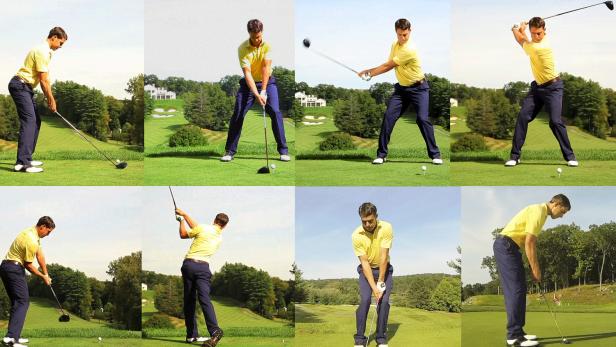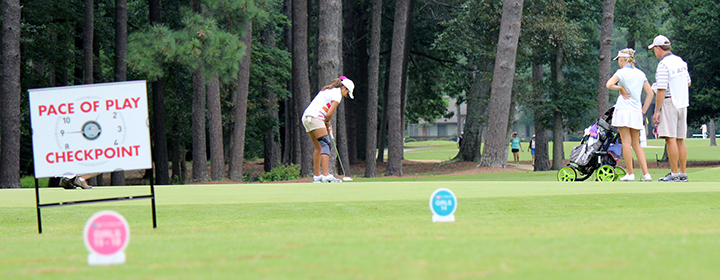
It is important that you open your stance when hitting a fade with your driver. Also, position your body so that your clubface is slightly to the left of the target. Then, swing along the line of your feet to achieve a slight curve in the ball. The more curvature the ball creates, the wider your stance. Teeing the ball down can create a negative angle and a club path.
Rotating your top hand
Rotating your upper hand is an important step in hitting fades when using a driver. Rotating your top-hand is a way to make the club feel softer and easier. Your tophand should be located at two knuckles away from address. If you can reach two knuckles from the address, you're on your way toward a fade together with a driver.
When you rotate your top hand to hit a fade with a driver, you'll want to keep the clubface open and a line of motion that will move the ball right. This will make the ball travel further through the air and allow for a more controlled fade. This technique can be used to improve your shot.
Clubface adjustment
You can adjust your clubface in order to hit a driver fade. This is a great way for consistent results while swinging. First, check your clubface during address and on your backswing. Then, adjust the angle of the clubface toward your target. But be careful not to open the clubface.

You can hit fades by using the correct grip and stance. Keep your shoulders down when you are hitting a fade. This will help stabilize your clubface while promoting a left to right swing. Remember, you don't want to hit your fade too far from the inside of the target, either.
Adjusting your body posture
Hitting a fade with a driver is a common golf shot that many players have trouble hitting. While some are more adept at hitting fades than others, others have trouble hitting them and end up with big slices or sudden hooks. No matter how good your golf game is, you can still learn how to hit the fade by moving your body.
To make your shot roll less and fly higher, adjust your body to hit a fade. This ball flight will be more flattering, and you'll be adding effective loft to your shot.
It is possible to create a natural swing pathway
Open your stance to a driver and hit a fade. Your driver should point at your target but slightly to the left. You can then swing the ball along the line between your feet. The ball will curve easier if you have a more open stance. If you want to hit the ball from a negative angle, another tip is to tee it down. This will cause your arms and hands to drop, creating an outside-in swing pathway.
Once you have your body in the right place, the next step will be to adjust your clubface. Your swing path should be adjusted according to whether you're a left- or right-handed golfer. Your face should point towards the right if you are a right-handed golfer. For left-handed golfers, your face should point to the right.

Alignment sticks are a great tool to practice your fade shots
Alignment sticks aid golfers in finding their stance and improving their golf swing mechanics. These tools can also be used on the chipping green, practice area, and home golf course to set a target. Alignment sticks are useful for golfers who need to know how to align the ball and determine the stance width.
You can use alignment sticks to practice your fade shots in a variety of ways. They can be used to launch balls onto the sticks from either the left or right, at various distances, to create a repeatable path. The sticks can also serve to monitor your swing plan and hip turn.
FAQ
What are the essential items to take on a trip to the golf course?
Take some snacks and drinks with you. Remember to bring your favorite t-shirt, sunglasses, gloves and towels.
What kind of clubs should I use?
There are many different types of clubs. A driver is a heavy-metal club that allows players to hit the ball farther. Other clubs include woods, irons, wedges, and putters.
Woods are longer clubs, designed to let players get as close to the pin as possible while still being able reach the green. They are typically used for long drives and approaches.
Irons are shorter clubs, which are made to allow players to hit the ball closer towards the pin. These clubs are used often for chipping and putting, as well as short-distance shots.
Wedges are specialized clubs that are used to control the flight path of the ball. They are typically used for shots that require precise direction.
Putters are small clubs used to move the ball towards the cup. These clubs are used to make short putts.
What type of shot do you want to make determines the type of club that you choose. Different types of shots are better served by different clubs.
Drivers, for example, are helpful in hitting the ball further away than the hole. Wooden are perfect for driving the ball long distances. Irons are perfect for short shots. Wedges are great at controlling the ball's flight. Putters are ideal for rolling the ball into holes.
How does golf work?
Golf is played over 18 holes using the Rules of Golf.
The first stroke is taken from behind a designated teeing area. Players take turns hitting the balls into holes placed at various distances throughout the course. Each hole is different depending on the distance to the teeing areas.
There are three types of shots that can be used in the game:
-
In a drive shot, players use clubs to hit the ball as far as possible. This shot is usually the most important in the game.
-
Players must aim for the ball in a specific area of the hole when they attempt an approach shot.
-
A putt in which players attempt to sink the ball down into the cup through rolling it along with the ground.
Every hole must be completed by a player sinking all of his/her own puts. Each unmade putt is a stroke loss.
It is possible for players to choose to play alongside a caddy or partner. This person will be responsible for carrying their club throughout a round. The caddie usually has no role in determining the outcome of the match but can assist the player with advice about strategy and etiquette.
What is the difference between a driving course and a putting-green?
A driving range allows players to practice hitting balls from distances of 50 yards to 300 yards. Players use putting greens to practice their skills.
Statistics
- They do this by means of assessing and rating courses according to the average good score of a "bogey golfer," a player with a handicap of around 20. (en.wikipedia.org)
- Professional golfers typically make between 60% and 70% of greens in regulation. (en.wikipedia.org)
- Professional golfers typically make between 60% and 70% of greens in regulation. (en.wikipedia.org)
- In the United States, the number of people who play golf twenty-five times or more per year decreased from 6.9 million in 2000 to 4.6 million in 2005, according to the [51] (en.wikipedia.org)
External Links
How To
How To Make A Perfect Swing In Golf
A great golfer knows how to play the game and what to do to improve it. He must understand how to use the various grips, stances and swings.
These tips can help you to master golf.
-
Be familiar with the fundamentals of golf before you can begin to improve your game.
-
Practice makes perfect. The best way to practice your skills is to go outside and hit the balls at a target. This gives you the opportunity to improve your form and technique while not causing yourself any harm. As soon as you feel comfortable with the mechanics of your swing, try playing a few rounds of golf.
-
Make sure you're ready - Before hitting any ball, check your grip, stance, posture, alignment, club choice, and the distance to the target. Adjust if you don't feel the right way.
-
Keep it simple - Don't try to copy someone else's swing; take inspiration from great players like Tiger Woods, Phil Mickelson, Jack Nicklaus, Gary Player, Arnold Palmer, Ben Hogan, Ernie Els, Vijay Singh, Tom Watson, Sam Snead, Lee Trevino, etc. They are masters of what they do because they have perfected it.
-
Use technology - Technology plays an important role in improving your golf game. There are many apps today that can help analyze your swing, track distances, give you tips, and even provide statistics to assist you in making better decisions.
-
Be consistent. When you practice, remember the following principles: * Focus on one aspect at a time. You should focus on only the short game drills if you are working on your shorter game. Don't mix long and short drills.
-
Only one part of the body is important at a time. For example: If you work hard on your left side, forget about the right side. It will not improve your overall game.
-
Always be truthful. Never lie to your self. If you think that you are doing more than you actually do, then you are cheating yourself.
-
Play with friends. Having fun with others can help you get better at your game. You will be more motivated if you have friends around.
-
Know your strengths and weaknesses - Find out where you excel and where you need improvement.
-
Have fun. Enjoy learning golf. There is no such thing "perfect" at any skill. You'll enjoy the journey even if you don't achieve perfection.